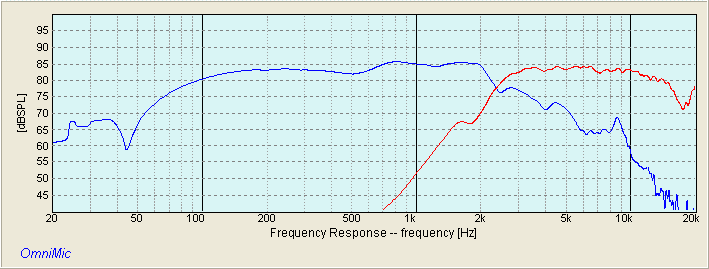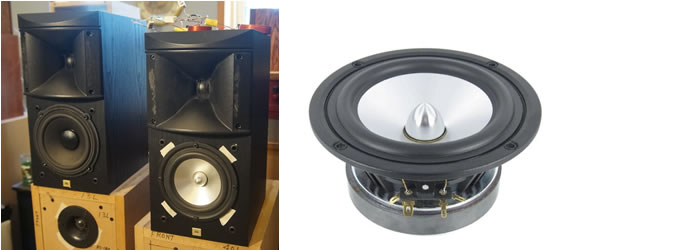|
Swift-HT5
If your JBL HT5 midwoofers are damaged, fear not, help is at hand. It just so happens that Zaph ZA14 fits perfectly in the cutout. All you have to do is drill four new holes to mount the ZA14, install a new crossover and you not only re-purpose your HT5, they will even sound better.
Removing the midwoofer

This should have been a simple exercise. Remove the midwoofer mounting screws and lift it. Not so. The midwoofer simply refused to budge.
Apparently, JBL decided to use some kind of sealant instead of a paper gasket. I had to use a flat tip screwdriver to pry it off. Be careful doing this. You can scar the box.
A simpler way is to remove the horn tweeter first. To do this, peel away the two vertical strips at the sides. This will expose the mounting screws. After you remove the horn, stick your hand into the box and try to push the midwoofer out from under.
Zaph ZA14 in JBL HT5 box
 Fig 1 – Frequency Response of ZA14 in HT5 box. Mic at 1 meter, tweeter axis. Impulse Window = 5ms. No Smoothing. Fig 1 – Frequency Response of ZA14 in HT5 box. Mic at 1 meter, tweeter axis. Impulse Window = 5ms. No Smoothing.
The Black plot is the RAW response of the ZA14 in the JBL HT5 box. The Blue plot is with a 2nd order low pass filter. Below 500Hz is the Nearfield measurement that I overlaid. This is a better representation because at 5ms window, my room reflections are interfering with the measurement.
Zaph ZA14 with JBL HT5 Horn

Fig 2 – Frequency Response of ZA14 with Low Pass filter and HT5 horn with High Pass filter
Fig 2 shows the responses of the ZA14 with the HT5 bi-radial horn. Acoustically, they are crossing at about 2.5kHz. I avoided taming the ZA14 peak at 8.5kHz. I doubt it will interfere with the treble.
Swift-HT5 Frequency Response

Fig 3 – Summed Response of ZA14 and HT5 bi-radial horn.
The Frequency Response of the Swift HT5 is shown in Fig 3. The two drivers sum beautifully in the crossover. They are like made for each other. As I expected, the 8.5kHz peak of the ZA14 is not a problem.
Swift-HT5 Cumulative Spectral Decay

Fig 4 – Swift HT5 Waterfall plot. Window = 1.3ms (769Hz), Time Range = 1.0ms, Rise Time = 0.1ms
With a Time Range of only 1ms (Fig 4), it is easy to see how clean the Swift HT5 is. As I expected, the HT5 bi-radial horn tweeter is outstanding.
Swift-HT5 Toneburst Energy Storage

Fig 5 – Swift HT5 Toneburst Energy Storage. Impulse Window = 5ms.
The Toneburst Energy Storage (Fig 5) shows there’s minimal excess energy in the Swift HT5.
Swift-HT5 vs JBL HT5 Frequency Response

Fig 6 – Frequency Response of Swift-HT5 and Original HT5. Mic at 1meter, tweeter axis. Impulse Window=5ms. No smoothing.
Measurements below 500Hz are in Nearfield.
In Fig 6, we can see the differences between the Swift HT5 and the JBL HT5. The Black plot in Fig 6 is the Swift HT5. The Blue plot is the frequency response of the original HT5. Measurments below 500Hz are in Nearfield.
In the Swift HT5, I voiced the midrange to be slightly higher whereas in the JBL’s version, it is slightly lower. My treble is a tad softer compared to my midrange. JBL’s is a bit higher than their midrange.
Things become real interesting below 500Hz. In JBL’s HT5, there is a hump centering about 250Hz. I believe this is where the nasalness in the original HT5 stems from.
Below 250Hz, the JBL’s HT5 roll off is quite abrupt. At 125Hz, it slopes at about 15dB per octave linearly. It appears that JBL designed in a 125Hz high pass in their HT5. This makes perfect sense. Surrounds are not supposed to produced bass.
So now I know why the HT5 sounded a bit odd when I used them for mains. But to be fair, they were never meant for that.
The Swift HT5, in comparison, has a more gradual and natural roll-off. Also, there’s more bass, about +6dB more.
Swift-HT5 Impedance

Fig 7 – Swift HT5 Impedance
There’s nothing unusual with the Swift HT5 impedance (Fig 7). From the saddle on the left, we can see the box tuning is at 50Hz. This is perfect for the ZA14. I tuned my Swift-X enclosure at 50Hz too.
JBL HT5 Impedance

Fig 8 – JBL HT5 Impedance
Fig 8 is the original JBL HT5 impedance. What jumps out from this plot is the box tuning. Instead of a nice saddle as is normally seen in a bass reflex tuning, this looks like the port output is reduced. This reaffirms what I said earlier about the HT5. Being surrounds, there’s no need for bass.
How to use the Swft-HT5
If you enjoy listening to vocals, the Swift HT5 can be used without subwoofers. There is enough bass for The Girl in the Other Room (Diana Krall) to sound perfectly fine. Amapola (Andrea Bocelli) is amazing. I really don’t know how many octaves his voice spans. It just doesn’t seem possible.
For music with low bass, like rock/pop etc, I suggest adding a subwoofer. The bass extension makes the music more organic.
the sound of Swift-HT5
The Swift HT5 sounds very lively and realistic. This is the kind of reproduction that transports me to another dimension.
This conversion is well worth the effort and expense. I can’t be happier how well it turned out. |


 Fig 1 – Frequency Response of ZA14 in HT5 box. Mic at 1 meter, tweeter axis. Impulse Window = 5ms. No Smoothing.
Fig 1 – Frequency Response of ZA14 in HT5 box. Mic at 1 meter, tweeter axis. Impulse Window = 5ms. No Smoothing.





